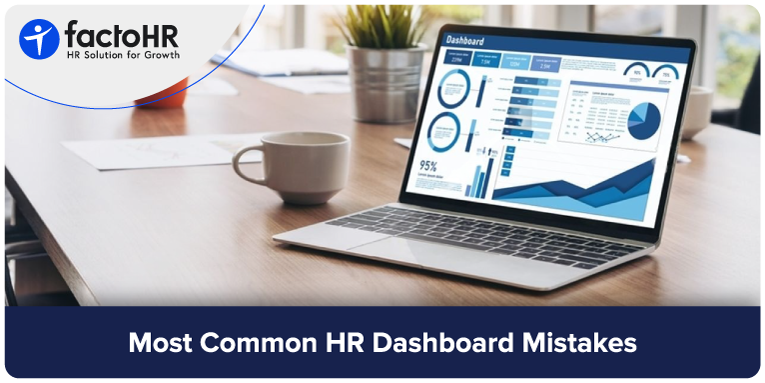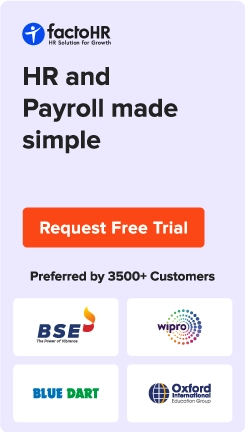7 Most Common HR Dashboard Mistakes (How to Avoid?)

Table of Contents
In today’s fast-paced world, real-time data analysis is a must for workforce management. This is why HR analytics is an important element in the decision-making process. Thus, HR dashboards play a critical role in the success of any business.
HR analytics dashboards optimize various HR operations by simplifying data analysis. They help analyze hiring patterns and are invaluable in monitoring employee performance. Other HR operations, such as payroll management, compliance tracking, and talent management, can also be streamlined by using HR dashboards.
HR dashboards combine, analyze, and monitor various metrics related to workforce management. They provide visual, interactive charts related to several key analytics such as turnover rates, performance metrics, and payroll-related information. These functions reiterate the importance of having a well-configured dashboard.
However, some common pitfalls include overcustomization, lack of accurate data, and a non-mobile-friendly interface. All these pitfalls could create problems while making strategic HR decisions. This blog will provide insightful solutions and help you avoid the 7 common HR dashboard mistakes.
7 Most Common HR Dashboard Mistakes to Avoid
It could be that you are tracking too many metrics, which is making the interface more cluttered. It could also be that your managers and HR professionals are not satisfied with the data analysis provided by the dashboards. All these mistakes have actionable solutions. Let’s examine these common HR Dashboard mistakes and their solutions in more detail.

Tracking Too Many Metrics
Mistake: Sometimes, organizations over-customize the dashboard, resulting in increased clutter. This could lead to a range of issues, from data fragmentation to delays in decision-making. Too many metrics could also confuse managers and make the decision-making process more difficult rather than simpler.
How to avoid: You should have separate dashboards for different metrics. For example, a recruitment dashboard should only have analytics related to recruitment, such as cost-per-hire and time-to-hire. Additionally, if you wish to use different options, choose a model with a filter metrics list. For instance, having demographic filters would be helpful if you want to know the cost-per-hire in a particular location. You can also customize tags and their settings to have a clutter-free dashboard.
Inaccurate and Outdated Data
Mistake: One of the other major HR dashboard issues is inaccurate data. Outdated performance data could make aligning HR strategies with business goals challenging. Hiring biases may also contribute to similar issues. According to Business Wire, 70% of organizations have low confidence in their data quality when making decisions. This discovery emphasizes the necessity of identifying a practical solution for data quality problems.
How to avoid: You should clearly define the data sources, processes, and standards to follow while gathering data. Prefer an integrated solution. It would help minimize data inconsistencies. HR professionals should conduct regular data audits to identify any potential discrepancies and validate the data quality if necessary.
Poor Data Visualization
Mistake: Sometimes, the dashboard shows all the HR reports but doesn’t provide the data in an interactive format, such as a chart. If the charts are available, they are not properly labeled or captioned. All these issues would confuse HR managers and negatively impact the efficiency of your HR leaders.
How to avoid: You should opt for an HR dashboard with interactive charts. Making organizational charts with tools like Visio would also make the available information more interactive.
Ignoring the End-User (HR or Management)
Mistake: Not considering HR professionals and managers while designing dashboards could create a number of issues, as managers would use dashboards to make decisions.
How to avoid: Leaders should include HR professionals and managers while designing the dashboard. Executives should also use interactive self-service portals to gather real-time feedback from managers.
Lack of Contextual Insights
Mistake: At times, leaders tend to add irrelevant metrics to the dashboard. For example, a dashboard related to performance should only have performance metrics. A lack of contextual insights would complicate any problem rather than solve it.
How to avoid: You should sift through relevant metrics and choose only those that can be correlated with your goal. Relying on predictive analytics and other HR analytics to identify correlations would also help select key metrics.
Not Mobile Optimized
Mistake: Smartphones are the new digital offices. Not having a mobile-friendly dashboard can make it difficult to access relevant information on time. Also, even if the dashboard can be accessed on the phone, the lack of mobile-friendly navigation would complicate matters.
How to avoid: You should consider solutions that follow a mobile-first approach. If you built your own dashboard, ensure it can be easily viewed on a smartphone.
Failing to Update and Improve
Mistake: Outdated data could affect almost all HR operations, including payroll processing, performance assessment, and recruitment management. Lack of timely and accurate data in any of these processes could make it difficult to make prompt decisions.
How to avoid: You should integrate your dashboard with third-party applications to update real-time data. Various HR solutions offer integrated dashboards, enabling you to access real-time information such as performance, recruitment, and payroll analytics.

Conclusion
This blog thoroughly explored some of the most common HR dashboard mistakes. It also explicitly focuses on common issues like data inaccuracies, the temptation to over-customize, and cluttered layouts that can make things confusing. To tackle these issues, some practical solutions were also provided to make the dashboards more effective. As organizations continue to depend on data and HR analytics to make informed decisions, it’s clear that HR dashboards will become even more critical in the future.
Having insightful data will benefit any organization in the long run, as AI and HR analytics advancements will require data to make informed decisions. So, HR dashboards are here to stay and will impact all HR operations in the near future.
What Metrics Should be on an HR Dashboard?
A general HR dashboard should include headcount, gender, education, and other general metrics. Meanwhile, specialized dashboards, such as recruitment dashboards, should consist of metrics such as cost-per-hire, time-to-hire, and quality per hire.
How Often Should HR Dashboards be Updated?
HR dashboards should be updated in real-time for two reasons
- Real-time updates would eliminate data inconsistency by providing timely data, and
- Real-time updates also help in prompt decision-making.
What Makes a Good HR Dashboard?
A good HR dashboard is
- Relevant: The best HR dashboards have only relevant metrics.
- Responsive: It updates in real-time and allows access to current metrics related to various HR operations.
- Interactive: It provides interactive charts for managing employee information.
- It has an intuitive and clutter-free interface.
- It can be easily accessed on smartphones.
Grow your business with factoHR today
Focus on the significant decision-making tasks, transfer all your common repetitive HR tasks to factoHR and see the things falling into their place.

© 2025 Copyright factoHR


